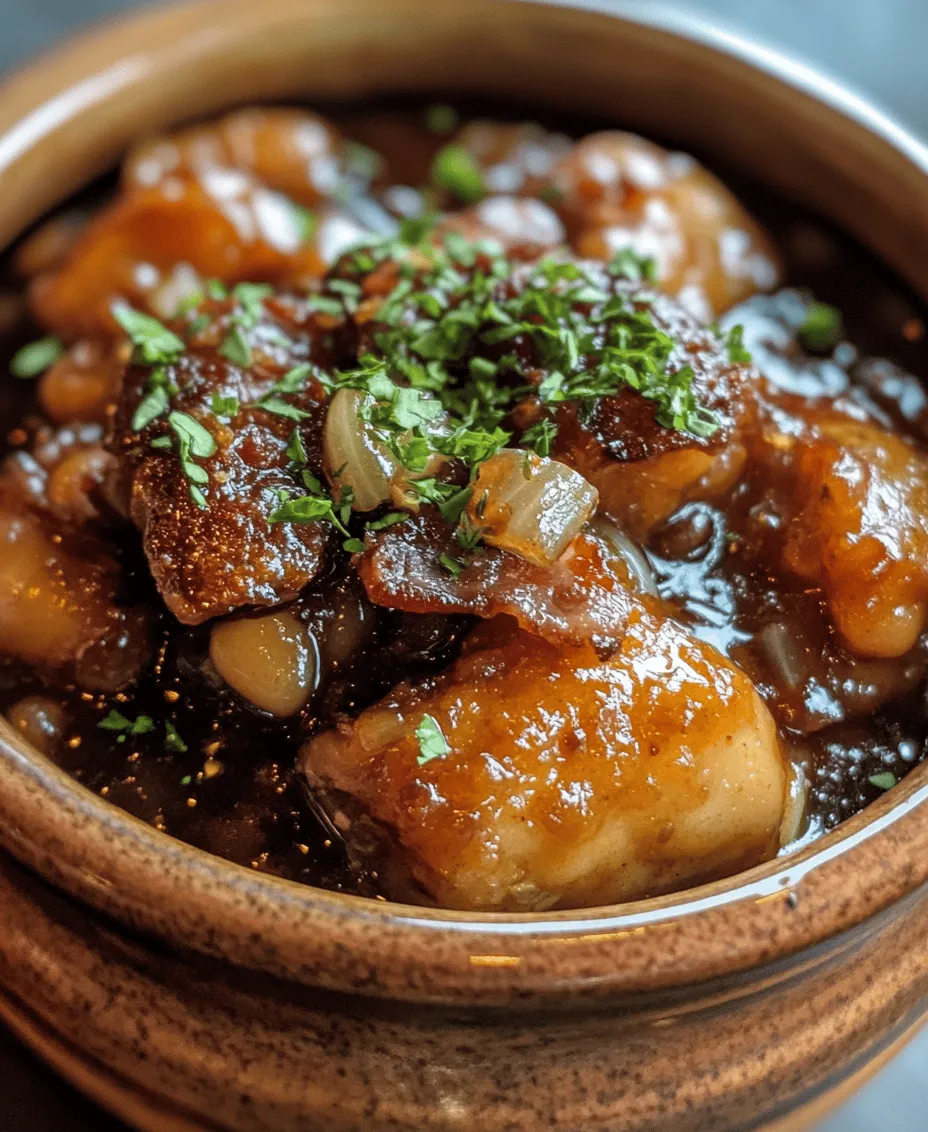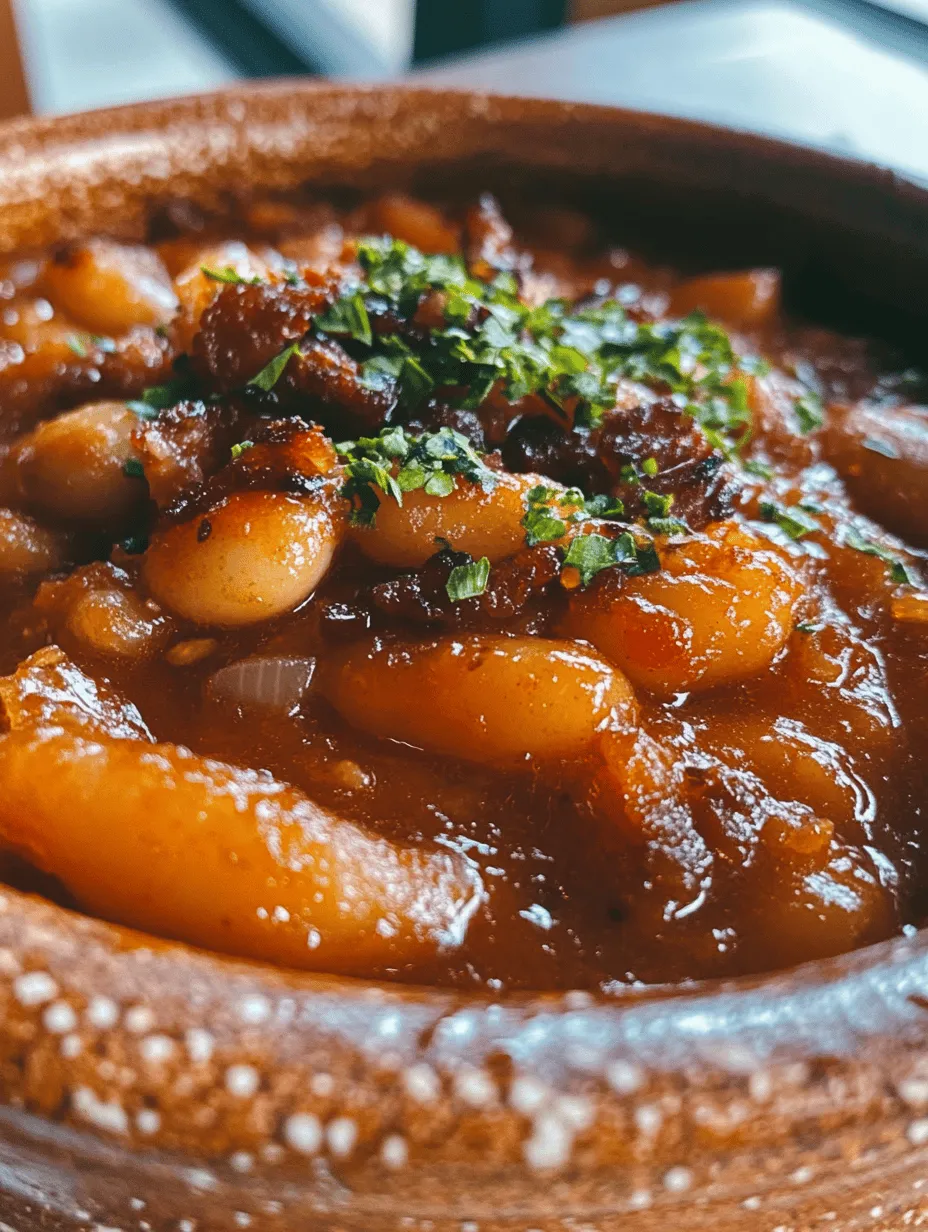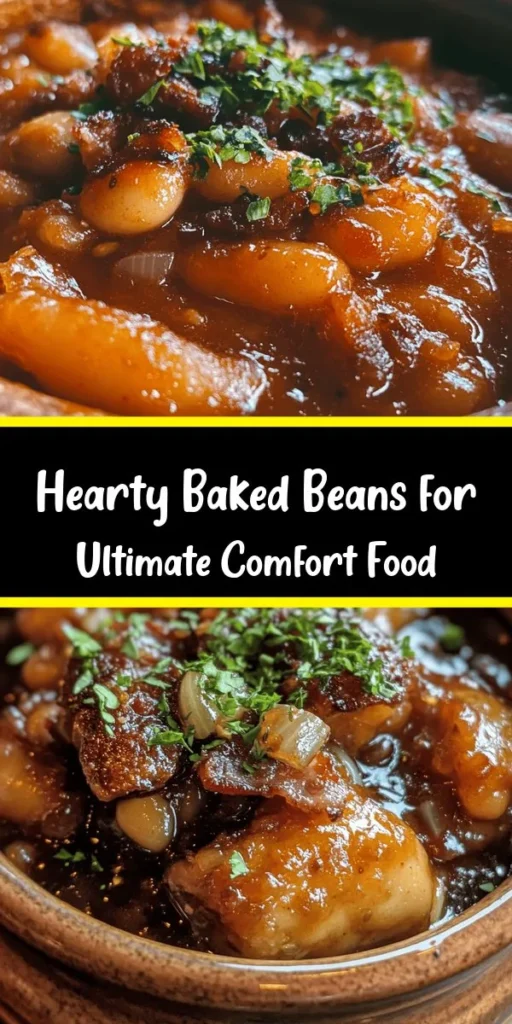Introduction
Baked beans are more than just a dish; they are a comforting staple that evokes nostalgia and warmth in many cultures around the world. Often associated with family gatherings, barbecues, and potlucks, this hearty dish holds a special place in the hearts (and stomachs) of countless individuals. Baked beans are a versatile option that can be served as a side or enjoyed as the main attraction, adapting seamlessly to various cuisines and occasions.
Whether you’re savoring a picnic on a sunny day or sitting down to a cozy dinner during the colder months, baked beans bring a sense of comfort that few dishes can match. What sets this particular recipe apart is its simplicity, rich flavors, and the customizable nature that allows it to cater to different palates. With a perfect balance of sweetness, acidity, and umami, these baked beans are bound to become a favorite in your home.
Understanding Baked Beans
The origins of baked beans trace back centuries, with roots in Native American cuisine where beans were cooked in clay pots over an open fire. The evolution of this dish has seen it transform from a simple survival food into a beloved comfort dish across various cultures. In America, baked beans became a staple during the colonial era, particularly in New England, where they were often slow-cooked with molasses and salt pork. Over time, each region has added its own twist, leading to a delightful array of baked bean recipes that highlight local flavors.
Nutritionally, beans are a powerhouse of health benefits. They are an excellent source of plant-based protein, making them ideal for vegetarians and those seeking healthier meal options. High in fiber, beans promote digestive health and help maintain a feeling of fullness, making them a perfect addition to any meal. Furthermore, beans are rich in essential vitamins and minerals, including iron, potassium, and folate, contributing to a balanced diet.
In American cuisine, baked beans are often featured in classic summer barbecues, Thanksgiving feasts, and even breakfast menus in some regions. Their versatility allows them to pair beautifully with grilled meats, serve as a topping for baked potatoes, or stand alone as a satisfying vegetarian dish. This adaptability not only highlights their cultural significance but also their universal appeal.
Ingredient Breakdown
Creating the perfect batch of baked beans requires a careful selection of ingredients, each playing a crucial role in building depth of flavor and texture. Here’s a closer look at the key components that make this dish so comforting:
Navy Beans: The Best Choice
When it comes to baked beans, navy beans are often considered the gold standard. Their small, oval shape and mild flavor allow them to absorb the delicious seasonings and sauces used in the recipe. Navy beans also have a creamy texture once cooked, which contributes to the overall mouthfeel of the dish. While other beans can be used, such as pinto or kidney beans, navy beans are traditionally preferred for their ability to hold up during the baking process.
Ketchup: Sweet and Tangy Base
Ketchup is a quintessential ingredient in many baked bean recipes, providing a sweet and tangy foundation that complements the beans perfectly. The acidity from the tomatoes helps to balance the richness of the dish, enhancing the overall flavor profile. It acts as a glue for all the other ingredients, ensuring that each bite is packed with flavor.
Brown Sugar: Enhancing Sweetness and Caramelization
Brown sugar adds a delightful sweetness to the baked beans while also promoting caramelization during the cooking process. This caramelization not only enhances the dish’s flavor but also contributes to the beautiful, glossy finish that baked beans are known for. The molasses in brown sugar adds depth, making it a crucial ingredient for a well-rounded flavor.
Apple Cider Vinegar: Adding Acidity and Depth
A splash of apple cider vinegar is essential for balancing the sweetness of the dish. This tangy component cuts through the richness of the beans and brings brightness to the overall flavor. Additionally, the acidity helps to tenderize the beans, ensuring they cook evenly and absorb all the delicious flavors.
Worcestershire Sauce: Umami Flavor Enhancement
Worcestershire sauce is a secret weapon in many savory dishes, including baked beans. Its complex flavor profile, which includes hints of vinegar, molasses, and spices, adds depth and a touch of umami that elevates the dish. A few dashes of this sauce can transform your baked beans into a flavor powerhouse.
Spices: The Importance of Smoked Paprika, Black Pepper, Garlic, and Onion Powder
The right blend of spices is what truly sets baked beans apart. Smoked paprika brings a gentle smokiness that enhances the beans without overpowering them. Black pepper adds warmth and a touch of heat, while garlic and onion powder contribute to the aromatic base of the dish. Together, these spices create a well-rounded flavor that makes each bite satisfying.
The Role of Bacon (Optional): Adding Richness and Flavor
For those who enjoy a meaty flavor in their baked beans, adding bacon can take the dish to a new level. The rendered fat from the bacon infuses the beans with richness, while the smoky flavor complements the other ingredients beautifully. If you’re looking for a vegetarian alternative, consider using smoked paprika or liquid smoke to mimic that savory depth without the meat.
Olive Oil and Onions: The Foundation of a Great Sauté
A solid base of sautéed onions and olive oil is essential for building flavor in baked beans. Onions add sweetness and depth, while olive oil ensures everything cooks evenly and prevents sticking. Sautéing the onions until they are translucent and fragrant creates a delicious foundation for the rest of the ingredients.
Preparation Steps Explained
Now that we’ve explored the significance of baked beans and their ingredients, let’s delve into the preparation steps that will guide you in creating this comforting dish.
Preheating the Oven: Importance of Temperature
Before embarking on your baked bean journey, one crucial step is preheating your oven. This ensures that your beans cook evenly and develop that coveted caramelized top. Set your oven to 350°F (175°C) to achieve the perfect baking environment. A properly preheated oven allows for consistent cooking, which is essential for achieving the right texture and flavor in your baked beans.
As you prepare the other ingredients, the oven will be warming up, creating a seamless cooking experience. Once your beans are ready to go, you’ll be able to transfer them straight to the oven, ensuring they begin cooking immediately and develop that rich, comforting flavor we all love.
With the oven preheating, you can start gathering your ingredients and preparing your kitchen for the delightful cooking process ahead. From sautéing the onions and layering the flavors to baking them to perfection, every step will bring you closer to enjoying a hearty serving of comforting baked beans.
Stay tuned for the next part of this article, where we’ll dive deeper into the detailed instructions for assembling and baking your baked beans, ensuring they turn out perfectly every time!

Cooking Bacon: Tips for Achieving the Perfect Crispness
To create a comforting baked beans dish, the bacon plays an essential role, contributing both flavor and texture. To achieve the perfect crispness, start by choosing high-quality bacon, preferably with a good balance of meat and fat. A thicker cut will provide better texture and prevent the bacon from becoming too chewy during the cooking process.
When cooking the bacon, use a large skillet over medium heat, allowing the fat to render slowly. This process will help the bacon crisp up evenly without burning. Cook the bacon strips for about 6-8 minutes, flipping them occasionally with tongs, until they reach a rich golden brown. Once cooked, remove the bacon from the skillet and place it on a paper towel-lined plate to absorb excess grease. This will ensure that your bacon retains its crispness when mixed into the baked beans.
Sautéing Onions: Techniques for Maximizing Flavor
Sautéing the onions is another crucial step that enhances the overall flavor profile of your baked beans. Start with a medium-sized onion, finely chopped. In the same skillet used for the bacon, add a tablespoon of oil if necessary, and heat it over medium heat. Once hot, add the chopped onions and a pinch of salt to help them release moisture.
Cook the onions for about 5-7 minutes, stirring frequently until they become translucent and slightly caramelized. This process brings out their natural sweetness and flavor. For an extra flavor boost, consider adding minced garlic during the last minute of cooking, allowing it to become fragrant without burning. The combination of sautéed onions and garlic will provide a robust base for your baked beans.
Combining Ingredients: Ensuring Even Distribution of Flavors
With the bacon cooked and the onions sautéed, it’s time to combine all the ingredients. In a large mixing bowl, add the cooked beans, crispy bacon, sautéed onions, and the remaining ingredients, which typically include brown sugar, mustard, ketchup, Worcestershire sauce, and a sprinkle of black pepper.
To ensure an even distribution of flavors, gently fold the ingredients together with a spatula, being careful not to mash the beans. The goal is to integrate all components while maintaining the integrity of the beans. This step is essential for achieving a harmonious blend of flavors in every bite.
Transferring to a Baking Dish: Why Even Spreading Matters
Once all the ingredients are combined, it’s time to transfer the mixture to a baking dish. Choose a 2-quart baking dish or a 9×13 inch casserole dish for optimal cooking. Before pouring in the bean mixture, lightly grease the dish with cooking spray or a small amount of oil to prevent sticking.
When transferring the mixture, use the spatula to evenly spread the beans across the bottom of the baking dish. This even spreading is crucial as it allows the beans to cook uniformly, ensuring that each bean has the opportunity to absorb the flavors from the sauce. An even layer also promotes consistent heating, preventing some beans from becoming overcooked while others remain undercooked.
Baking Process: Understanding the Importance of Covered vs. Uncovered Baking
Now that the beans are in the baking dish, it’s time to bake. Preheat your oven to 350°F (175°C) and cover the dish tightly with aluminum foil. This covered baking will help the beans cook thoroughly while retaining moisture. Bake for about 30 minutes.
After the initial baking period, remove the foil and continue baking for an additional 15-20 minutes uncovered. This step allows the top to caramelize slightly, creating a delightful contrast in texture and enhancing the flavors. The uncovered baking also reduces excess moisture, thickening the sauce for a perfect consistency.
Serving Suggestions
Ideal Accompaniments: What to Serve with Baked Beans
Baked beans are incredibly versatile and can be enjoyed on their own or paired with various side dishes. For a classic meal, consider serving your baked beans alongside cornbread. The sweetness of cornbread complements the savory flavors of the beans beautifully. Additionally, coleslaw or a fresh garden salad can provide a crisp, refreshing contrast to the rich, hearty beans.
Classic Pairings: Cornbread, Grilled Meats, and Salads
At outdoor gatherings or barbecues, baked beans shine when served alongside grilled meats such as ribs, burgers, or hot dogs. The smoky flavors from the grill enhance the beans’ taste, creating a perfect harmony of flavors. For a complete meal, add a side of cornbread and a light salad. The combination of textures and flavors will satisfy any palate and create a memorable dining experience.
Creative Variations: Using Baked Beans in Tacos, on Nachos, or in Casseroles
For a fun twist, consider using your baked beans as a filling for tacos or as a topping for nachos. Simply spoon the beans into taco shells, add your favorite toppings such as cheese, sour cream, and avocado, and enjoy a delicious and hearty meal. Alternatively, layer baked beans on tortilla chips with cheese and jalapeños for a baked nacho dish that’s sure to impress at any gathering.
You can also use baked beans as a base for casseroles. Combine them with cooked ground meat, vegetables, and a layer of mashed potatoes or cheese on top, then bake until bubbly for a comforting dish that’s perfect for family dinners.
Ideal Occasions for Serving Baked Beans
Baked beans are a staple at family gatherings, barbecues, and potlucks. Their comforting nature and ability to feed a crowd make them a go-to dish for any casual occasion. Whether celebrating a holiday, hosting a summer BBQ, or simply enjoying a cozy family dinner, baked beans offer warmth and satisfaction.
Storage and Reheating Tips
Best Practices for Storing Leftovers
If you have leftover baked beans, they can be stored in an airtight container in the refrigerator for up to 3-5 days. Allow the beans to cool to room temperature before transferring them to the container to prevent condensation, which can lead to sogginess.
How to Reheat Baked Beans Without Losing Texture and Flavor
To reheat the baked beans, gently warm them on the stovetop over low heat, stirring occasionally until heated through. Alternatively, you can use the microwave; simply place the beans in a microwave-safe container, cover with a lid or microwave-safe wrap, and heat in short intervals, stirring in between to ensure even heating. Adding a splash of water or broth during reheating can help maintain moisture and prevent the beans from drying out.
Freezing Baked Beans: Tips and Considerations
Baked beans freeze exceptionally well, making them a convenient option for meal prep. To freeze, allow the beans to cool completely, then transfer them to a freezer-safe container or a resealable plastic bag. Be sure to leave some space at the top of the container or bag, as the beans will expand when frozen. Frozen baked beans can last for up to 3-6 months. When ready to enjoy, thaw them overnight in the refrigerator and reheat using the stovetop or microwave methods described above.
Variations on the Classic Recipe
Vegetarian and Vegan Adaptations
While traditional baked beans often include bacon, you can easily adapt the recipe for vegetarian or vegan diets. To maintain the savory flavor, consider using smoked paprika or liquid smoke for that rich, smoky taste. You can also add sautéed mushrooms or tempeh for a hearty texture that mimics the meaty flavor.
Different Flavor Profiles: Spicy, Sweet, and Smoky Variations
Experiment with different flavor profiles by adding spices or ingredients to suit your taste. For a spicy kick, consider incorporating diced jalapeños or a dash of cayenne pepper. If you prefer a sweeter profile, increase the amount of brown sugar or add maple syrup for a unique twist. For a smoky variation, try using smoked beans or stirring in some chipotle sauce for a deep, rich flavor.
Incorporating Seasonal Ingredients for a Fresh Twist
Seasonal ingredients can elevate your baked beans to the next level. In summer, consider adding fresh corn or diced tomatoes for a burst of freshness. In the fall, stir in roasted butternut squash or pumpkin for a cozy autumn-inspired dish. These variations not only enhance the flavor but also add nutritional value to your meal.
Conclusion
Baked beans are a truly comforting dish that brings warmth and satisfaction to any meal. With their rich flavors and hearty texture, they have the potential to become a family favorite. Whether you stick to the classic recipe or explore the various adaptations and flavor profiles, baked beans offer versatility that can cater to every palate.
As you venture into the kitchen, don’t hesitate to experiment with the recipe. Include your favorite spices, try new accompaniments, and make it your own. Home-cooked meals, like baked beans, have a unique ability to bring people together, fostering connection and creating lasting memories around the dinner table. Embrace the joy of cooking and enjoy the delicious rewards that come with it.



